Abstract
Cationic compounds used in the treatment of veterinary African trypanosomiasis have structural properties similar to those of pentamidine, which has been used in the therapy of human trypanosomiasis and infection with Pneumocystis carinii. We have compared the activities of these drugs and other antimicrobial agents in an immunosuppressed rat model of P. carinii pneumonia. Diminazene, imidocarb, amicarbalide, quinapyramine, and isometamidium showed efficacy greater than or equal to that of pentamidine in the therapy of P. carinii infection, whereas ethidium and methylglyoxal bis(guanylhydrazone) were only slightly active against the organism. Diminazene and pentamidine also exhibited comparable efficacy in P. carinii prophylaxis, alpha-Difluoromethylornithine (DFMO), a polyamine inhibitor, was ineffective therapy when used alone and did not improve the effectiveness of pentamidine or diminazene. Quinine, quinidine, quinacrine, chlorpromazine, spiramycin, Pentostam, Astiban, dehydroemetine, ampicillin, gentamicin, chloramphenicol, and spectinomycin also showed little or no activity against the organism. Thus, in this model anti-P. carinii activity appears to be a common property of veterinary cationic trypanocidal compounds. This should be important in studying structure-activity relationships and in developing new drugs for the treatment of P. carinii infection in humans.
Full text
PDF

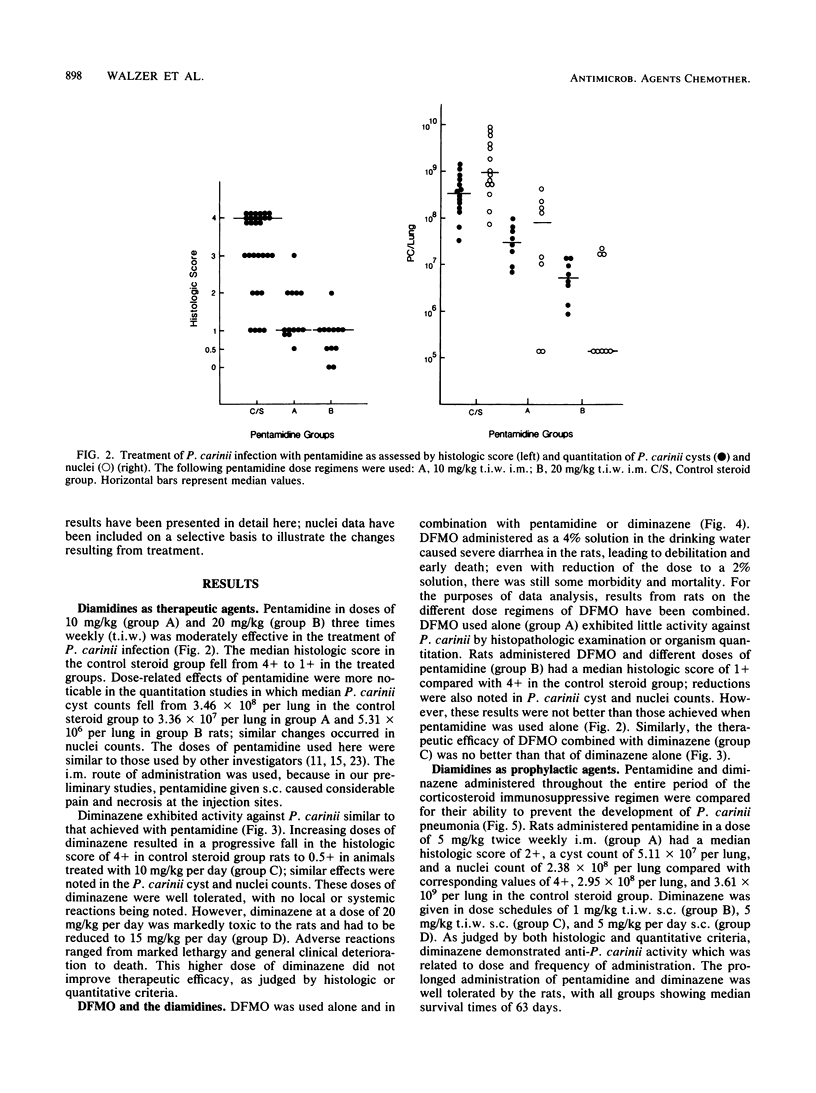
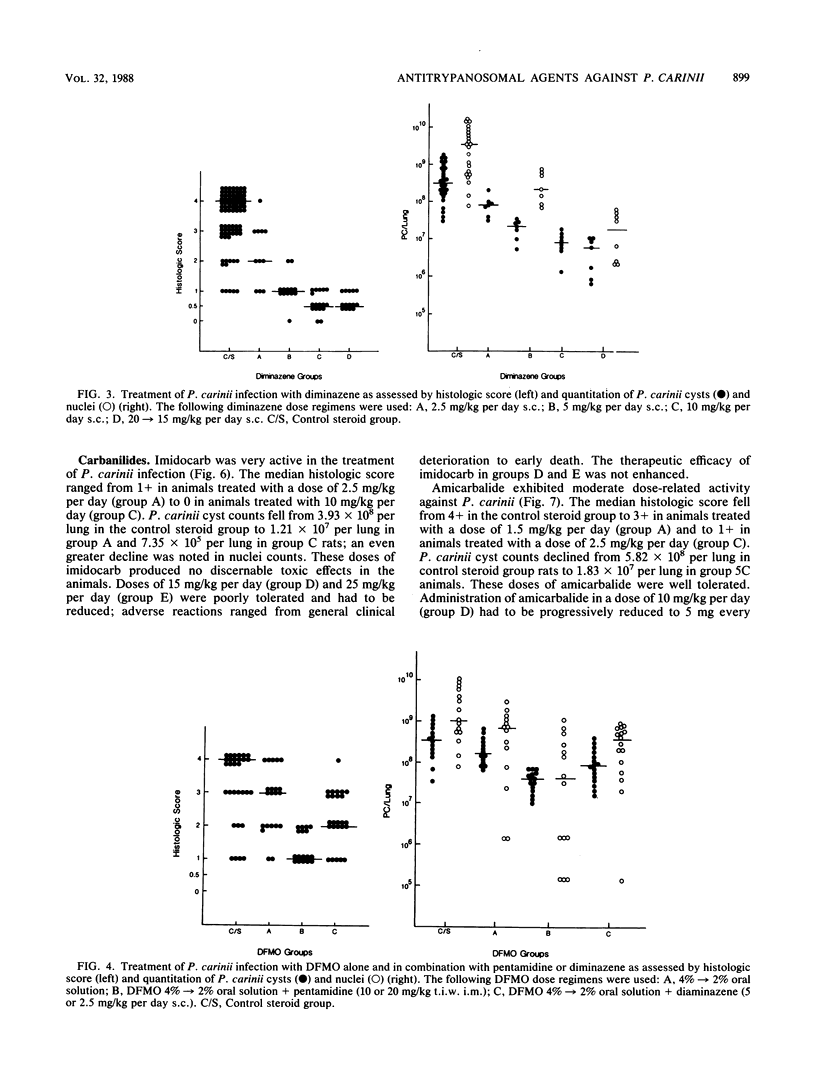
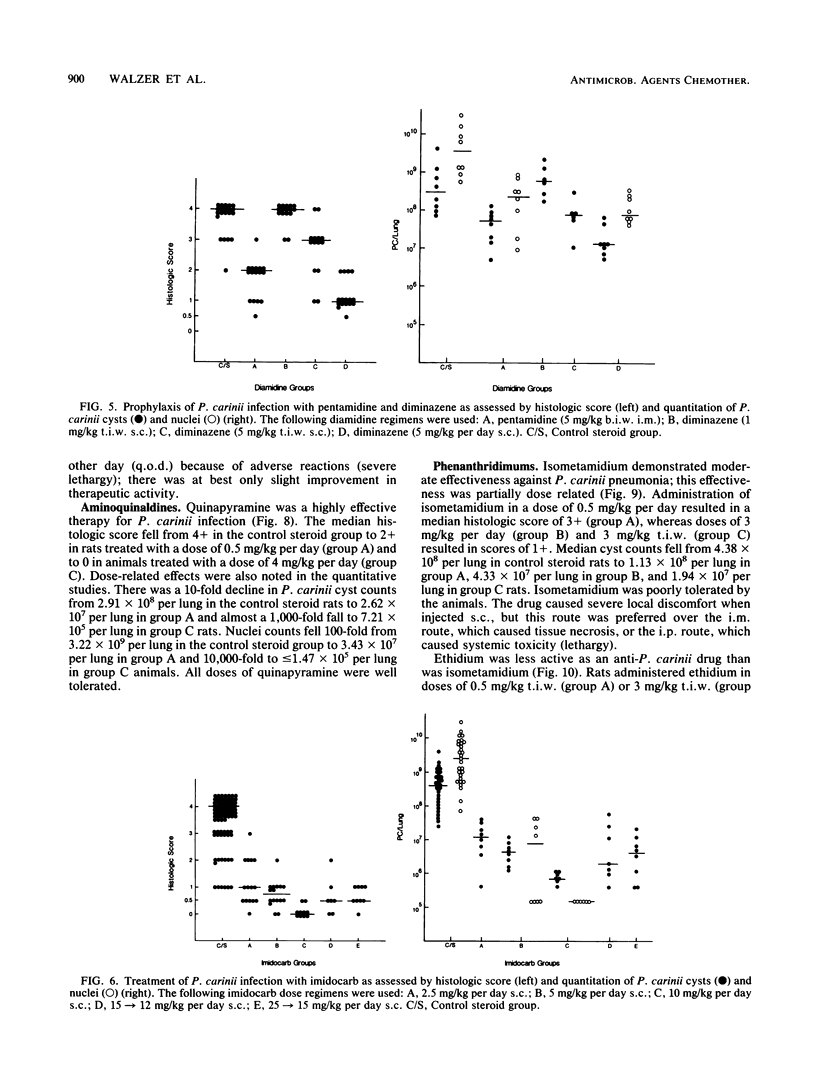

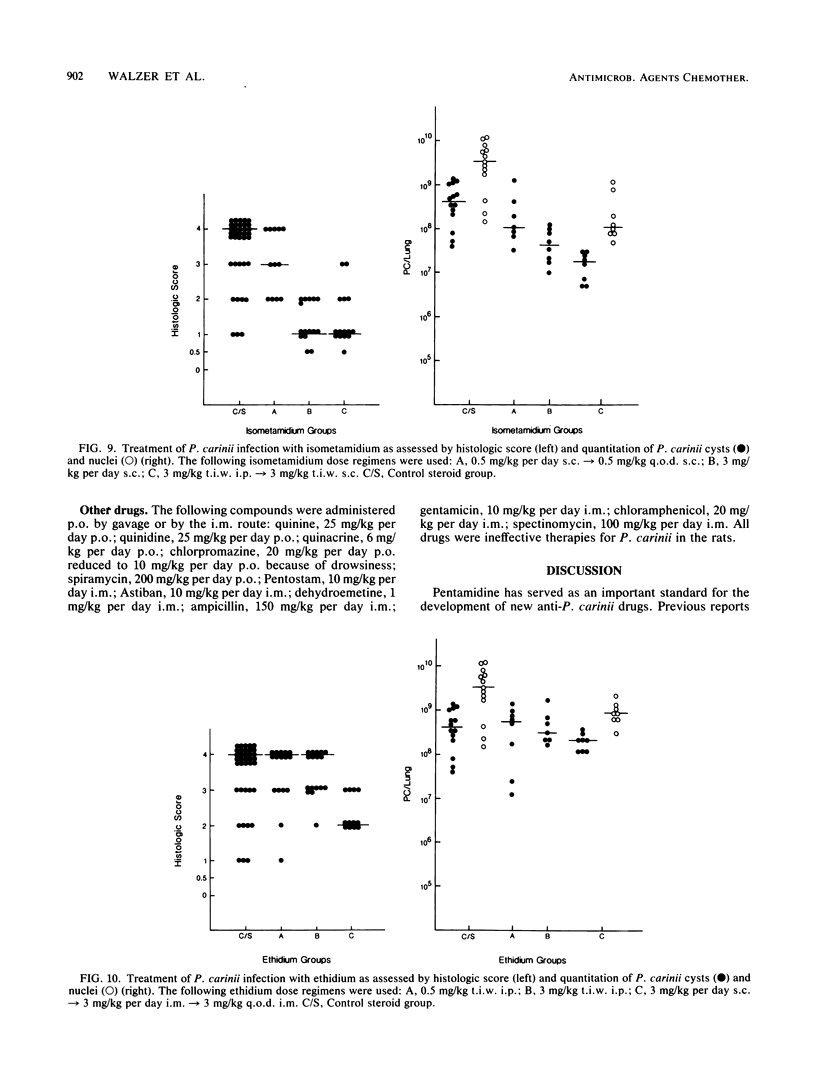

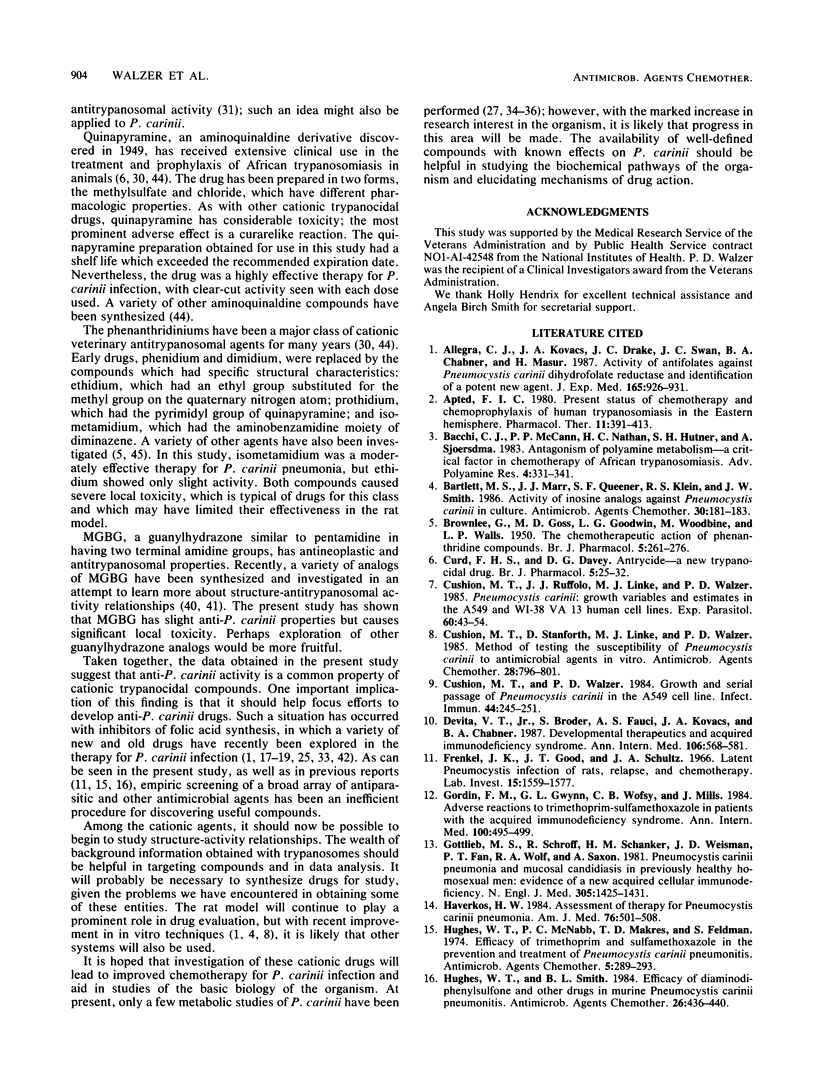
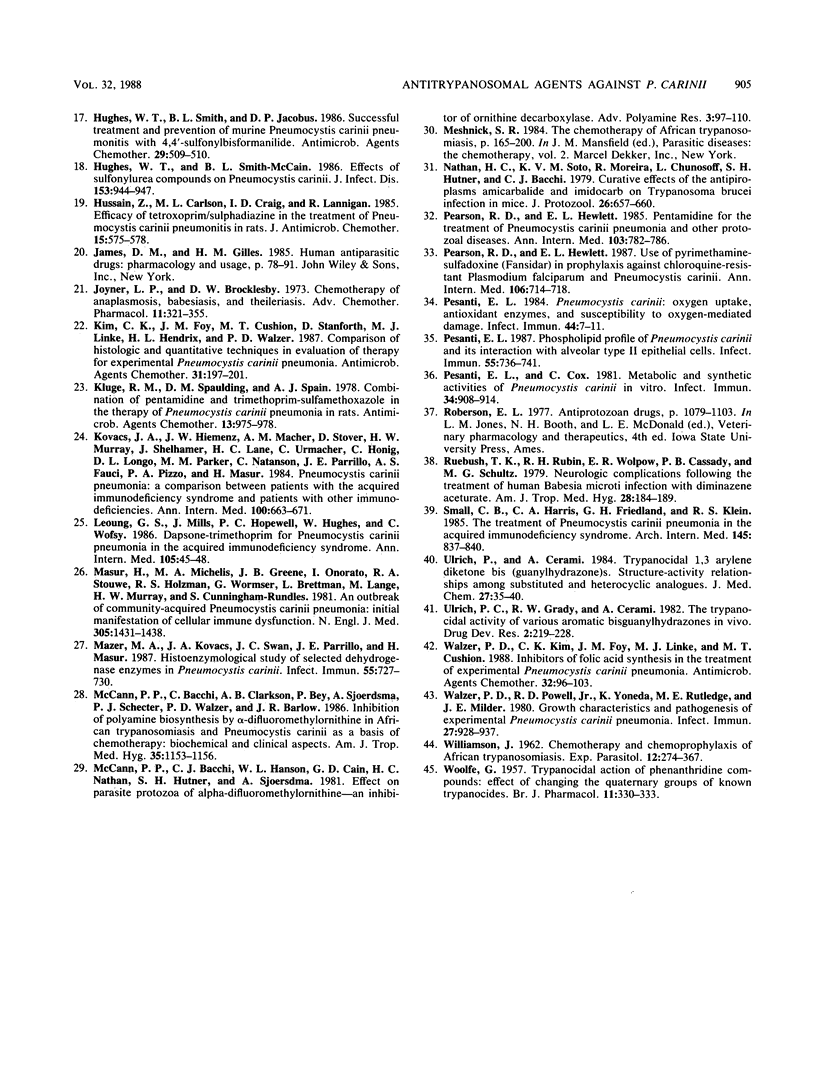
Selected References
These references are in PubMed. This may not be the complete list of references from this article.
- Allegra C. J., Kovacs J. A., Drake J. C., Swan J. C., Chabner B. A., Masur H. Activity of antifolates against Pneumocystis carinii dihydrofolate reductase and identification of a potent new agent. J Exp Med. 1987 Mar 1;165(3):926–931. doi: 10.1084/jem.165.3.926. [DOI] [PMC free article] [PubMed] [Google Scholar]
- Apted F. I. Present status of chemotherapy and chemopropylaxis of human trypanosomiasis in the Eastern Hemisphere. Pharmacol Ther. 1980;11(2):391–413. doi: 10.1016/0163-7258(80)90035-2. [DOI] [PubMed] [Google Scholar]
- BROWNLEE G., GOSS M. D., GOODWIN L. G., WOODBINE M., WALLS L. P. The chemotherapeutic action of phenanthridine compounds. I. Trypanosoma congolense and Trypanosoma rhodesiense. Br J Pharmacol Chemother. 1950 Jun;5(2):261–276. doi: 10.1111/j.1476-5381.1950.tb01012.x. [DOI] [PMC free article] [PubMed] [Google Scholar]
- Bartlett M. S., Marr J. J., Queener S. F., Klein R. S., Smith J. W. Activity of inosine analogs against Pneumocystis carinii in culture. Antimicrob Agents Chemother. 1986 Jul;30(1):181–183. doi: 10.1128/aac.30.1.181. [DOI] [PMC free article] [PubMed] [Google Scholar]
- Cushion M. T., Ruffolo J. J., Linke M. J., Walzer P. D. Pneumocystis carinii: growth variables and estimates in the A549 and WI-38 VA13 human cell lines. Exp Parasitol. 1985 Aug;60(1):43–54. doi: 10.1016/s0014-4894(85)80021-7. [DOI] [PubMed] [Google Scholar]
- Cushion M. T., Stanforth D., Linke M. J., Walzer P. D. Method of testing the susceptibility of Pneumocystis carinii to antimicrobial agents in vitro. Antimicrob Agents Chemother. 1985 Dec;28(6):796–801. doi: 10.1128/aac.28.6.796. [DOI] [PMC free article] [PubMed] [Google Scholar]
- Cushion M. T., Walzer P. D. Growth and serial passage of Pneumocystis carinii in the A549 cell line. Infect Immun. 1984 May;44(2):245–251. doi: 10.1128/iai.44.2.245-251.1984. [DOI] [PMC free article] [PubMed] [Google Scholar]
- DeVita V. T., Jr, Broder S., Fauci A. S., Kovacs J. A., Chabner B. A. Developmental therapeutics and the acquired immunodeficiency syndrome. Ann Intern Med. 1987 Apr;106(4):568–581. doi: 10.7326/0003-4819-106-4-568. [DOI] [PubMed] [Google Scholar]
- Frenkel J. K., Good J. T., Shultz J. A. Latent Pneumocystis infection of rats, relapse, and chemotherapy. Lab Invest. 1966 Oct;15(10):1559–1577. [PubMed] [Google Scholar]
- Gordin F. M., Simon G. L., Wofsy C. B., Mills J. Adverse reactions to trimethoprim-sulfamethoxazole in patients with the acquired immunodeficiency syndrome. Ann Intern Med. 1984 Apr;100(4):495–499. doi: 10.7326/0003-4819-100-4-495. [DOI] [PubMed] [Google Scholar]
- Gottlieb M. S., Schroff R., Schanker H. M., Weisman J. D., Fan P. T., Wolf R. A., Saxon A. Pneumocystis carinii pneumonia and mucosal candidiasis in previously healthy homosexual men: evidence of a new acquired cellular immunodeficiency. N Engl J Med. 1981 Dec 10;305(24):1425–1431. doi: 10.1056/NEJM198112103052401. [DOI] [PubMed] [Google Scholar]
- Haverkos H. W. Assessment of therapy for pneumocystis carinii pneumonia. PCP Therapy Project Group. Am J Med. 1984 Mar;76(3):501–508. doi: 10.1016/0002-9343(84)90670-3. [DOI] [PubMed] [Google Scholar]
- Hughes W. T., McNabb P. C., Makres T. D., Feldman S. Efficacy of trimethoprim and sulfamethoxazole in the prevention and treatment of Pneumocystis carinii pneumonitis. Antimicrob Agents Chemother. 1974 Mar;5(3):289–293. doi: 10.1128/aac.5.3.289. [DOI] [PMC free article] [PubMed] [Google Scholar]
- Hughes W. T., Smith-McCain B. L. Effects of sulfonylurea compounds on Pneumocystis carinii. J Infect Dis. 1986 May;153(5):944–947. doi: 10.1093/infdis/153.5.944. [DOI] [PubMed] [Google Scholar]
- Hughes W. T., Smith B. L. Efficacy of diaminodiphenylsulfone and other drugs in murine Pneumocystis carinii pneumonitis. Antimicrob Agents Chemother. 1984 Oct;26(4):436–440. doi: 10.1128/aac.26.4.436. [DOI] [PMC free article] [PubMed] [Google Scholar]
- Hughes W. T., Smith B. L., Jacobus D. P. Successful treatment and prevention of murine Pneumocystis carinii pneumonitis with 4,4'-sulfonylbisformanilide. Antimicrob Agents Chemother. 1986 Mar;29(3):509–510. doi: 10.1128/aac.29.3.509. [DOI] [PMC free article] [PubMed] [Google Scholar]
- Hussain Z., Carlson M. L., Craig I. D., Lannigan R. Efficacy of tetroxoprim/sulphadiazine in the treatment of Pneumocystis carinii pneumonitis in rats. J Antimicrob Chemother. 1985 May;15(5):575–578. doi: 10.1093/jac/15.5.575. [DOI] [PubMed] [Google Scholar]
- Joyner L. P., Brocklesby D. W. Chemotherapy of anaplasmosis, babesiasis, and theileriasis. Adv Pharmacol Chemother. 1973;11:321–355. doi: 10.1016/s1054-3589(08)60461-5. [DOI] [PubMed] [Google Scholar]
- Kim C. K., Foy J. M., Cushion M. T., Stanforth D., Linke M. J., Hendrix H. L., Walzer P. D. Comparison of histologic and quantitative techniques in evaluation of therapy for experimental Pneumocystis carinii pneumonia. Antimicrob Agents Chemother. 1987 Feb;31(2):197–201. doi: 10.1128/aac.31.2.197. [DOI] [PMC free article] [PubMed] [Google Scholar]
- Kluge R. M., Spaulding D. M., Spain A. J. Combination of pentamidine and trimethoprim-sulfamethoxazole in therapy of Pneumocystis carinii pneumonia in rats. Antimicrob Agents Chemother. 1978 Jun;13(6):975–978. doi: 10.1128/aac.13.6.975. [DOI] [PMC free article] [PubMed] [Google Scholar]
- Kovacs J. A., Hiemenz J. W., Macher A. M., Stover D., Murray H. W., Shelhamer J., Lane H. C., Urmacher C., Honig C., Longo D. L. Pneumocystis carinii pneumonia: a comparison between patients with the acquired immunodeficiency syndrome and patients with other immunodeficiencies. Ann Intern Med. 1984 May;100(5):663–671. doi: 10.7326/0003-4819-100-5-663. [DOI] [PubMed] [Google Scholar]
- Leoung G. S., Mills J., Hopewell P. C., Hughes W., Wofsy C. Dapsone-trimethoprim for Pneumocystis carinii pneumonia in the acquired immunodeficiency syndrome. Ann Intern Med. 1986 Jul;105(1):45–48. doi: 10.7326/0003-4819-105-1-45. [DOI] [PubMed] [Google Scholar]
- Masur H., Michelis M. A., Greene J. B., Onorato I., Stouwe R. A., Holzman R. S., Wormser G., Brettman L., Lange M., Murray H. W. An outbreak of community-acquired Pneumocystis carinii pneumonia: initial manifestation of cellular immune dysfunction. N Engl J Med. 1981 Dec 10;305(24):1431–1438. doi: 10.1056/NEJM198112103052402. [DOI] [PubMed] [Google Scholar]
- Mazer M. A., Kovacs J. A., Swan J. C., Parrillo J. E., Masur H. Histoenzymological study of selected dehydrogenase enzymes in Pneumocystis carinii. Infect Immun. 1987 Mar;55(3):727–730. doi: 10.1128/iai.55.3.727-730.1987. [DOI] [PMC free article] [PubMed] [Google Scholar]
- McCann P. P., Bacchi C. J., Clarkson A. B., Jr, Bey P., Sjoerdsma A., Schecter P. J., Walzer P. D., Barlow J. L. Inhibition of polyamine biosynthesis by alpha-difluoromethylornithine in African trypanosomes and Pneumocystis carinii as a basis of chemotherapy: biochemical and clinical aspects. Am J Trop Med Hyg. 1986 Nov;35(6):1153–1156. doi: 10.4269/ajtmh.1986.35.1153. [DOI] [PubMed] [Google Scholar]
- Nathan H. C., Soto K. V., Moreira R., Chunosoff L., Hutner S. H., Bacchi C. J. Curative effects of the antipiroplasms amicarbalide and imidocarb on Trypanosoma brucei infection in mice. J Protozool. 1979 Nov;26(4):657–660. doi: 10.1111/j.1550-7408.1979.tb04215.x. [DOI] [PubMed] [Google Scholar]
- Pearson R. D., Hewlett E. L. Pentamidine for the treatment of Pneumocystis carinii pneumonia and other protozoal diseases. Ann Intern Med. 1985 Nov;103(5):782–786. doi: 10.7326/0003-4819-103-5-782. [DOI] [PubMed] [Google Scholar]
- Pearson R. D., Hewlett E. L. Use of pyrimethamine-sulfadoxine (Fansidar) in prophylaxis against chloroquine-resistant Plasmodium falciparum and Pneumocystis carinii. Ann Intern Med. 1987 May;106(5):714–718. doi: 10.7326/0003-4819-106-5-714. [DOI] [PubMed] [Google Scholar]
- Pesanti E. L., Cox C. Metabolic and synthetic activities of Pneumocystis carinii in vitro. Infect Immun. 1981 Dec;34(3):908–914. doi: 10.1128/iai.34.3.908-914.1981. [DOI] [PMC free article] [PubMed] [Google Scholar]
- Pesanti E. L. Phospholipid profile of Pneumocystis carinii and its interaction with alveolar type II epithelial cells. Infect Immun. 1987 Mar;55(3):736–741. doi: 10.1128/iai.55.3.736-741.1987. [DOI] [PMC free article] [PubMed] [Google Scholar]
- Pesanti E. L. Pneumocystis carinii: oxygen uptake, antioxidant enzymes, and susceptibility to oxygen-mediated damage. Infect Immun. 1984 Apr;44(1):7–11. doi: 10.1128/iai.44.1.7-11.1984. [DOI] [PMC free article] [PubMed] [Google Scholar]
- Ruebush T. K., 2nd, Rubin R. H., Wolpow E. R., Cassaday P. B., Schultz M. G. Neurologic complications following the treatment of human Babesia microti infection with diminazene aceturate. Am J Trop Med Hyg. 1979 Mar;28(2):184–189. doi: 10.4269/ajtmh.1979.28.184. [DOI] [PubMed] [Google Scholar]
- Small C. B., Harris C. A., Friedland G. H., Klein R. S. The treatment of Pneumocystis carinii pneumonia in the acquired immunodeficiency syndrome. Arch Intern Med. 1985 May;145(5):837–840. [PubMed] [Google Scholar]
- Ulrich P., Cerami A. Trypanocidal 1,3-arylene diketone bis(guanylhydrazone)s. Structure-activity relationships among substituted and heterocyclic analogues. J Med Chem. 1984 Jan;27(1):35–40. doi: 10.1021/jm00367a007. [DOI] [PubMed] [Google Scholar]
- WILLIAMSON J. Chemotherapy and chemoprophylaxis of African trypanosomiasis. Exp Parasitol. 1962 Aug;12:274–322. doi: 10.1016/0014-4894(62)90075-9. [DOI] [PubMed] [Google Scholar]
- WOOLFE G. Trypanocidal action of phenanthridine compounds: effect of changing the quaternary groups of known trypanocides. Br J Pharmacol Chemother. 1956 Sep;11(3):330–333. doi: 10.1111/j.1476-5381.1956.tb01076.x. [DOI] [PMC free article] [PubMed] [Google Scholar]
- Walzer P. D., Kim C. K., Foy J. M., Linke M. J., Cushion M. T. Inhibitors of folic acid synthesis in the treatment of experimental Pneumocystis carinii pneumonia. Antimicrob Agents Chemother. 1988 Jan;32(1):96–103. doi: 10.1128/aac.32.1.96. [DOI] [PMC free article] [PubMed] [Google Scholar]
- Walzer P. D., Powell R. D., Jr, Yoneda K., Rutledge M. E., Milder J. E. Growth characteristics and pathogenesis of experimental Pneumocystis carinii pneumonia. Infect Immun. 1980 Mar;27(3):928–937. doi: 10.1128/iai.27.3.928-937.1980. [DOI] [PMC free article] [PubMed] [Google Scholar]


